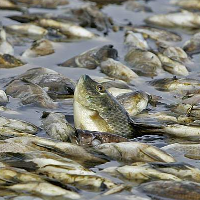Something Stinks Besides the Rotting Fish at the Salton Sea
 Dead and dying tilapia in the Salton Sea (photo: Jay Calderon, The Desert Sun)
Dead and dying tilapia in the Salton Sea (photo: Jay Calderon, The Desert Sun)
The Salton Sea is fading away, but its smell remains more pungent than ever and may be the source of stench that lingered over a broad swath of Southern California Monday.
Residents from the Salton Sea to the San Fernando Valley 150 miles away—in areas farther removed than at any time in recent memory—were enveloped with the smell of rotten eggs Monday, attributable to the sudden death of millions of tilapia, the dominant fish at the beleaguered saltwater lake.
“It's an unusual wind pattern that sent the Salton Sea smell pattern north,” Jack Crayon, an environmental scientist with the California Department of Fish and Game, told the San Bernardino Sun. The wind pattern is unusual, but not the massive seasonal die-off that is as predictable at the swallows returning to Capistrano. People near the Salton Sea were complaining 10 days ago about the stench, which has been made worse by oppressive heat and humidity.
But a statement from the South Coast Air Quality Management District left open the possibility that the odor could be from industrial sources like wastewater treatment plants.
The fish die when the lake, 30% more salty than the Pacific Ocean, heats up, depleting the water’s oxygen supply. Salt water carries less oxygen than fresh water. When the wind kicks up the nutrients in the water, algae blooms, consuming even more of the oxygen. An entire end of the lake has been known to turn green in a day.
It’s been that way for a long time and continues to get worse. The modern incarnation of the lake didn’t exist until 1905, when the Colorado River overflowed across a breached irrigation canal dike and snaked its way over to the salt-laden, low-lying area now known as the Salton Sea. The resulting lake was periodically refreshed with flows from the river until it was dammed in the ‘30s.
After that it became a popular resort, was stocked with sport fish and hosted a celebrity crowd for years until it became apparent in the ‘50s that the water’s salinity was increasing and it was shrinking. Discussions began about how to save the Salton Sea, but little came of them. The late congressman and former entertainer Sonny Bono took an interest in its restoration, and after his death, Mary Bono Mack, his widow and congressional successor, continued the cause.
State legislation in 2004 directed the Natural Resources Agency and the departments of Water Resources and Fish and Game to come up with a plan save the lake, which had developed into a thriving ecosystem and become a critical habitat for migrating birds. A 25-year, $8.9 billion restoration project was proposed.
A 2008 report by the Legislative Analyst’s Office (LAO) looked at multiple plans for preserving the lake and concluded that the state had no option but to pony up the money and move ahead quickly on implementing one of the proposals. The Salton Sea Restoration Council was created by the state in 2010 with the directive to settle on a plan by June 30, 2013, but by then the economy had blown up and it was hard to ignore the LAO’s key observation that “no viable funding plan for the restoration effort exists.”
Governor Jerry Brown’s 2011-12 budget proposed that the 16-member council be eliminated.
–Ken Broder
To Learn More:
Widespread Stink Mostly Blamed on Salton Sea (by Perry Smith and Lila Littlejohn, The Santa Clarita Valley Signal)
Efforts to Save Dying Sea Dry up at State Capitol (by Keith Matheny, The Desert Sun)
For Desolate, Shrinking Salton Sea, Another Dream (by Jennifer Medina, New York Times)
Salton Sea's Star Has Fallen (by Tony Perry, Los Angeles Times)
Restoring the Salton Sea (Legislative Analyst’s Office) (pdf)
- Top Stories
- Controversies
- Where is the Money Going?
- California and the Nation
- Appointments and Resignations
- Unusual News
- Latest News
- California Forbids U.S. Immigration Agents from Pretending to be Police
- California Lawmakers Urged to Strip “Self-Dealing” Tax Board of Its Duties
- Big Oil’s Grip on California
- Santa Cruz Police See Homeland Security Betrayal in Use of Gang Roundup as Cover for Immigration Raid
- Oil Companies Face Deadline to Stop Polluting California Groundwater





